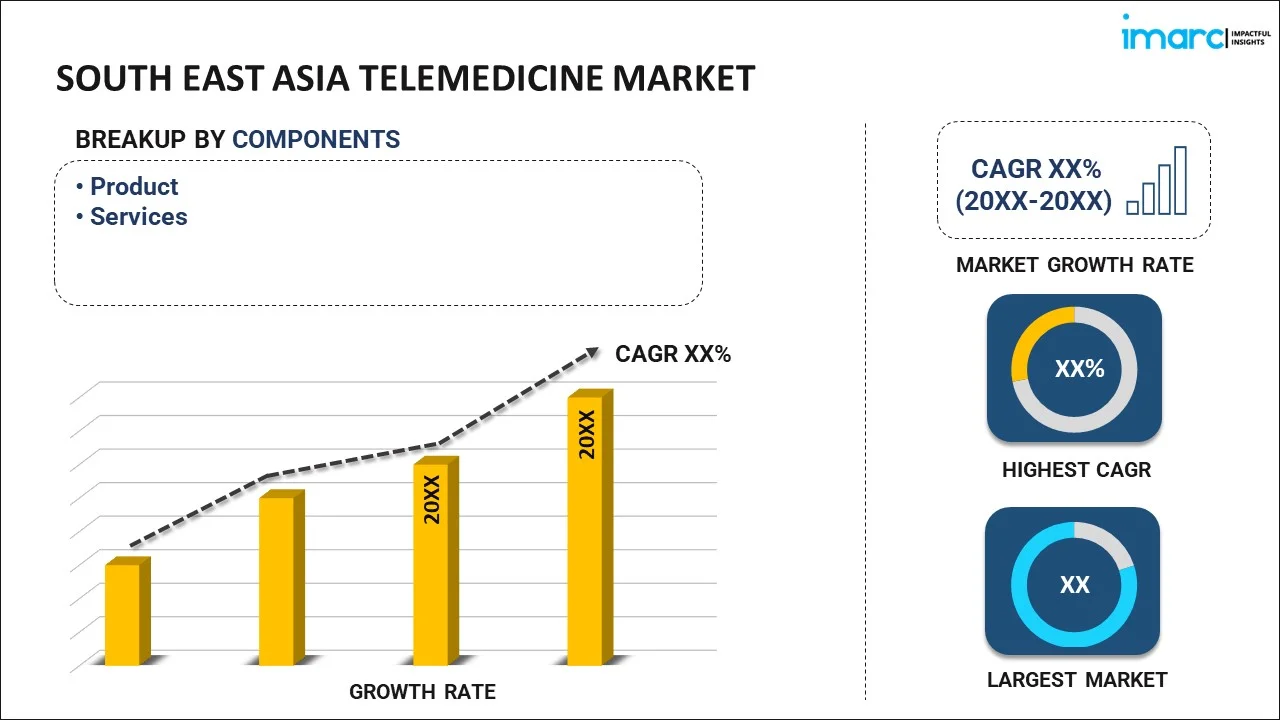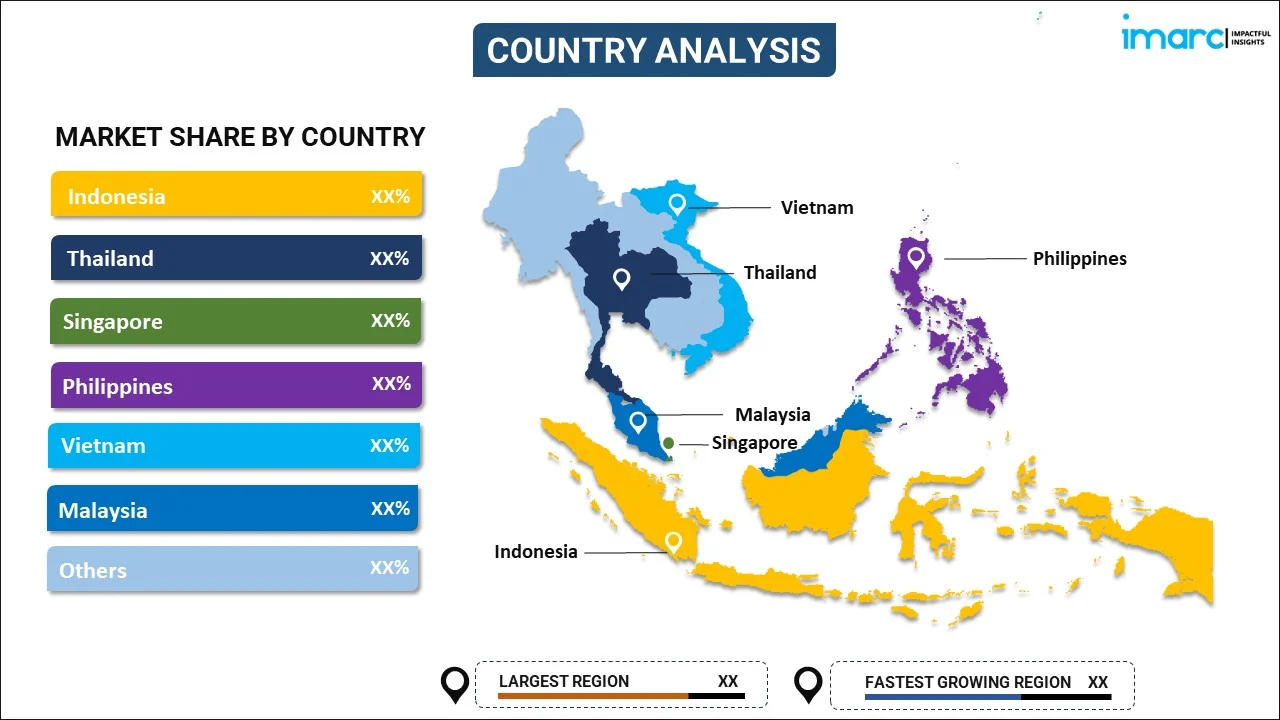
South East Asia Telemedicine Market Report by Component (Product, Services), Modality (Real-time, Store and Forward, and Others), Delivery Mode (Web/Mobile, Call Centers), Facility (Tele-Hospital, Tele-Home), Application (Teledermatology, Teleradiology, Telepsychiatry, Telepathology, Telecardiology, and Others), End User (Providers, Payers, Patients, and Others), and Country 2025-2033
Market Overview:
South East Asia telemedicine market size is projected to exhibit a growth rate (CAGR) of 13.38% during 2025-2033. The continuous advancements in communication technology, particularly in high-speed internet and mobile connectivity, which have facilitated the widespread adoption of telemedicine solutions, are driving the market.
|
Report Attribute
|
Key Statistics
|
|---|---|
|
Base Year
|
2024 |
|
Forecast Years
|
2025-2033
|
|
Historical Years
|
2019-2024
|
| Market Growth Rate (2025-2033) | 13.38% |
Telemedicine is a healthcare practice that leverages digital communication technologies to remotely provide medical services and consultations. It allows patients to access healthcare professionals and receive medical advice, diagnoses, and treatment from the comfort of their homes. Through video calls, phone consultations, and other online platforms, telemedicine enables real-time communication between patients and healthcare providers. This approach proves particularly beneficial in situations where physical visits are challenging or impossible for individuals in remote locations for those with mobility issues. Telemedicine enhances healthcare accessibility, reduces travel burdens, and facilitates timely interventions. However, it also poses challenges related to technology access and security, and its effectiveness may vary depending on the nature of medical issues. Despite these considerations, telemedicine continues to play a crucial role in improving healthcare delivery and expanding medical services.
South East Asia Telemedicine Market Trends:
The telemedicine market in South East Asia has witnessed substantial growth in recent years, driven by a confluence of factors that underscore the increasing demand for remote healthcare solutions. Firstly, advancements in technology have played a pivotal role in expanding the scope and accessibility of telemedicine services. With the proliferation of high-speed internet and the widespread adoption of smartphones, individuals now have the means to connect with healthcare professionals seamlessly. Moreover, the integration of artificial intelligence and data analytics in telemedicine platforms has enhanced diagnostic capabilities and personalized patient care. Secondly, the regional imperative for efficient and cost-effective healthcare solutions has propelled the telemedicine market forward. Telemedicine offers a scalable and resource-efficient alternative, particularly in remote or underserved areas where access to traditional healthcare facilities may be limited. Furthermore, the ongoing emphasis on preventive healthcare and early intervention has positioned telemedicine as a valuable tool for timely medical consultations and monitoring. Besides this, the need for social distancing and the strain on traditional healthcare systems, which have underscored the importance of telemedicine in providing remote consultations, thereby ensuring continuity of care, is expected to drive the market in South East Asia during the forecast period.
South East Asia Telemedicine Market Segmentation:
IMARC Group provides an analysis of the key trends in each segment of the market, along with forecasts at the country level for 2025-2033. Our report has categorized the market based on component, modality, delivery mode, facility, application, and end user.
Component Insights:

- Product
- Hardware
- Software
- Others
- Services
- Tele-Consulting
- Tele-Monitoring
- Tele-Education
The report has provided a detailed breakup and analysis of the market based on the component. This includes product (hardware, software, and others) and services (tele-consulting, tele-monitoring, and tele-education).
Modality Insights:
- Real-Time
- Store and Forward
- Others
A detailed breakup and analysis of the market based on the modality have also been provided in the report. This includes real-time, store and forward, and others.
Delivery Mode Insights:
- Web/Mobile
- Audio/Text-based
- Visualized
- Call Centers
The report has provided a detailed breakup and analysis of the market based on the delivery mode. This includes web/mobile (audio/text-based and visualized) and call centers.
Facility Insights:
- Tele-Hospital
- Tele-Home
A detailed breakup and analysis of the market based on the facility have also been provided in the report. This includes tele-hospital and tele-home.
Application Insights:
- Teledermatology
- Teleradiology
- Telepsychiatry
- Telepathology
- Telecardiology
- Others
The report has provided a detailed breakup and analysis of the market based on the application. This includes teledermatology, teleradiology, telepsychiatry, telepathology, telecardiology, and others.
End User Insights:
- Providers
- Payers
- Patients
- Others
A detailed breakup and analysis of the market based on the end user have also been provided in the report. This includes providers, payers, patients, and others.
Country Insights:

- Indonesia
- Thailand
- Singapore
- Philippines
- Vietnam
- Malaysia
- Others
The report has also provided a comprehensive analysis of all the major regional markets, which include Indonesia, Thailand, Singapore, Philippines, Vietnam, Malaysia, and Others.
Competitive Landscape:
The market research report has also provided a comprehensive analysis of the competitive landscape. Competitive analysis such as market structure, key player positioning, top winning strategies, competitive dashboard, and company evaluation quadrant has been covered in the report. Also, detailed profiles of all major companies have been provided.
South East Asia Telemedicine Market Report Coverage:
| Report Features | Details |
|---|---|
| Base Year of the Analysis | 2024 |
| Historical Period | 2019-2024 |
| Forecast Period | 2025-2033 |
| Units | Million USD |
| Scope of the Report | Exploration of Historical and Forecast Trends, Industry Catalysts and Challenges, Segment-Wise Historical and Predictive Market Assessment:
|
| Components Covered |
|
| Modalities Covered | Real-time, Store and Forward, Others |
| Delivery Modes Covered |
|
| Facilities Covered | Tele-hospital, Tele-home |
| Applications Covered | Teledermatology, Teleradiology, Telepsychiatry, Telepathology, Telecardiology, Others |
| End Users Covered | Providers, Payers, Patients, Others |
| Countries Covered | Indonesia, Thailand, Singapore, Philippines, Vietnam, Malaysia, Others |
| Customization Scope | 10% Free Customization |
| Post-Sale Analyst Support | 10-12 Weeks |
| Delivery Format | PDF and Excel through Email (We can also provide the editable version of the report in PPT/Word format on special request) |
Key Questions Answered in This Report:
- How has the South East Asia telemedicine market performed so far and how will it perform in the coming years?
- What has been the impact of COVID-19 on the South East Asia telemedicine market?
- What is the breakup of the South East Asia telemedicine market on the basis of component?
- What is the breakup of the South East Asia telemedicine market on the basis of modality?
- What is the breakup of the South East Asia telemedicine market on the basis of delivery mode?
- What is the breakup of the South East Asia telemedicine market on the basis of facility?
- What is the breakup of the South East Asia telemedicine market on the basis of application?
- What is the breakup of the South East Asia telemedicine market on the basis of end user?
- What are the various stages in the value chain of the South East Asia telemedicine market?
- What are the key driving factors and challenges in the South East Asia telemedicine?
- What is the structure of the South East Asia telemedicine market and who are the key players?
- What is the degree of competition in the South East Asia telemedicine market?
Key Benefits for Stakeholders:
- IMARC’s industry report offers a comprehensive quantitative analysis of various market segments, historical and current market trends, market forecasts, and dynamics of the South East Asia telemedicine market from 2019-2033.
- The research report provides the latest information on the market drivers, challenges, and opportunities in the South East Asia telemedicine market.
- Porter's five forces analysis assist stakeholders in assessing the impact of new entrants, competitive rivalry, supplier power, buyer power, and the threat of substitution. It helps stakeholders to analyze the level of competition within the South East Asia telemedicine industry and its attractiveness.
- Competitive landscape allows stakeholders to understand their competitive environment and provides an insight into the current positions of key players in the market.
Need more help?
- Speak to our experienced analysts for insights on the current market scenarios.
- Include additional segments and countries to customize the report as per your requirement.
- Gain an unparalleled competitive advantage in your domain by understanding how to utilize the report and positively impacting your operations and revenue.
- For further assistance, please connect with our analysts.
 Inquire Before Buying
Inquire Before Buying
 Speak to an Analyst
Speak to an Analyst
 Request Brochure
Request Brochure
 Request Customization
Request Customization




.webp)




.webp)












